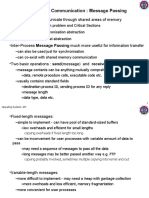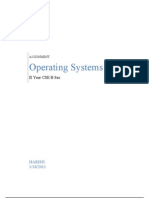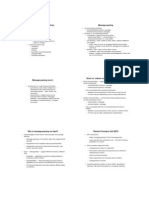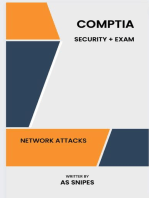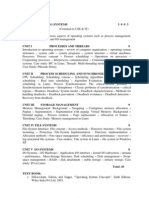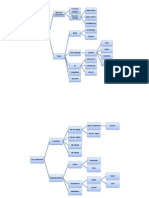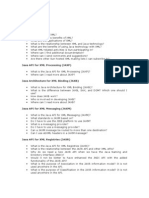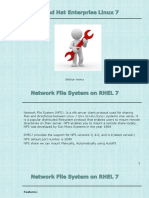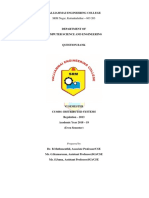EmbeddedSoftware6
Uploaded by
Ramiz KaraeskiEmbeddedSoftware6
Uploaded by
Ramiz KaraeskiEmbedded Systems
Prof. Dr. Faruk Bağcı
Prof. Dr. Mesut Güneş
CHAPTER OVERVIEW
• Introduction to Embedded Systems
• Embedded & Real-time Operating Systems
• Linux Kernel
• Peripheral Access
• Threads & Processes
• Memory
• Inter-process Communication
• Real-time Scheduling
• Interrupt Handling
• Advanced Topics
INTER-PROCESS COMMUNICATION
• Types of IPC
• Message passing
• Shared memory
• Message passing
• Blocking/non-blocking, …
• Datagrams, virtual circuits, streams
• Remote procedure calls
MESSAGE PASSING (I)
• Processes that want to exchange data send and receive
messages
• Any message exchange requires
• A send
• send(addr, msg, length);
• A receive
• receive(addr, msg, length);
MESSAGE PASSING (II)
send(…)
Sender msg Receiver
receive(…)
ADVANTAGES
• Very general
• Sender and receivers can be on different machines
• Relatively secure
• Receiver can inspect the messages it has received
before processing them
DISADVANTAGES
• Hard to use
• Every data transfer requires a send() and a
receive()
• Receiving process must expect the send()
• Might require forking a special thread
SHARED MEMORY
• Name says it
• Two or more processes share a part of their address
space
Process P
shared
Process Q
ADVANTAGES
• Fast and easy to use
• The data are there but
• Some concurrent accesses to the shared data can result
into small disasters
• Must synchronize access to shared data
• Topic will be covered in next chapter
DISADVANTAGES
• Not a general solution
• Sender and receivers must be on the same machine
• Less secure
• Processes can directly access a part of the address
space of other processes
MESSAGE PASSING
• Defining issues
• Direct/Indirect communication
• Blocking/Non-blocking primitives
• Exception handling
• Quality of service
• Unreliable/reliable datagrams
• Virtual circuits, streams
DIRECT COMMUNICATION (I)
• Send and receive system calls always specify
processes as destination or source:
• send(process, msg, length);
• receive(process, msg, length);
• Most basic solution because there is
• No intermediary between sender and receiver
AN ANALOGY
• Phones without switchboard
• Each phone is hardwired to another phone
DIRECT COMMUNICATION (II)
• Process executing the receive call must know the identity
of all processes likely to send messages
• Very bad solution for servers
• Servers have to answer requests from arbitrary processes
INDIRECT COMMUNICATION (I)
• Send and receive primitives now specify an
intermediary entity as destination or source: the
mailbox
• send(mailbox, msg, size);
• receive(mailbox, msg, size);
• Mailbox is a system object created by the kernel at the
request of a user process
AN ANALOGY (I)
• Phones with a switchboard
• Each phone can receive calls from any other phone
AN ANALOGY (II)
• Each phone has now a phone number
• Callers dial that number, not a person’s name
• Taking our phone with us allows us to receive phone
calls from everybody
INDIRECT COMMUNICATION (II)
• Different processes can send messages to the same
mailbox
• A process can receive messages from processes it does
not know anything about
• A process can wait for messages coming from
different senders
• Will answer the first message it receives
MAILBOXES
• Mailboxes can be
• Private
• Attached to a specific process
• Think of your cell phone
• Public
• System objects
• Think of a house phone
PRIVATE MAILBOXES
• Process that requested its creation and its children are the
only processes that can receive messages through the
mailbox are that process and its children
• Cease to exist when the process that requested its creation
(and all its children) terminates.
• Often called ports
• Example: BSD sockets
PUBLIC MAILBOXES
• Owned by the system
• Shared by all the processes having the right to receive
messages through it
• Survive the termination of the process that requested their
creation
• Work best when all processes are on the same machine
• Example: System V UNIX message queues
BLOCKING PRIMITIVES (I)
• A blocking send does not return until the receiving
process has received the message
• No buffering is needed
• Analogous to what is happening when you call
somebody who does not have voice mail
BLOCKING PRIMITIVES (II)
• A blocking receive does not return until a message has
been received
• Like waiting by the phone for an important message or
staying all day by your mailbox waiting for the mail
carrier
NON-BLOCKING PRIMITIVES (I)
• A non-blocking send returns as soon as the
message has been accepted for delivery by the OS
• Assumes that the OS can store the message in a
buffer
• Like mailing a letter: once the letter is dropped in the
mailbox, we are done
• The mailbox will hold your letter until a postal employee
picks it up
NON-BLOCKING PRIMITIVES (II)
• A non-blocking receive returns as soon as it has either
retrieved a message or learned that the mailbox is
empty
• Like checking whether your mail has arrived or not
NON-BLOCKING PRIMITIVES (III)
receive(…)
acts as a
retrieve(…)
Sender send(…) Receiver
Buffer
msg
SIMULATING BLOCKING RECEIVES
• Can simulate a blocking receive with a non- blocking
receive within a loop:
do {
code = receive(mbox,msg,size);
sleep(1); // delay
} while (code == EMPTY_MBOX);
• Known as a busy wait
• Costlier than a blocking wait
CLASSES OF SERVICE
• Datagrams:
• Messages are send one at time
• Virtual circuits:
• Ordered sequence of messages
• Connection-oriented service
• Streams:
• Ordered sequence of bytes
• Message boundaries are ignored
DATAGRAMS
• Each message is sent individually
• Some messages can be lost, other duplicated or arrive out
of sequence
• Equivalent of a conventional letter
• Reliable datagrams:
• resent until they are acknowledged
• Unreliable datagrams
VIRTUAL CIRCUITS (I)
• Establish a logical connection between the sender
and the receiver
• Messages are guaranteed to arrive in sequence
without lost messages or duplicated messages
• Same as the words of a phone conversation
VIRTUAL CIRCUITS (II)
• Require setting up a virtual connection before sending
any data
• Costlier than datagrams
• Best for transmitting large amounts of data that require
sending several messages
• File transfer protocol (FTP)
• Hypertext transfer protocol (HTTP)
STREAMS
• Like virtual circuits
• Do not preserve message boundaries:
• Receiver sees a seamless stream of bytes
• Offspring of UNIX philosophy
• Record boundaries do not count
• Message boundaries should not count
Remote Procedure
Calls
MOTIVATION (I)
• Apply to client-server model of computation
• A typical client-server interaction:
send_req(args); rcv_req(&args);
process(args, &results);
send_reply(results);
rcv_reply(&results);
MOTIVATION (II)
• Very similar to a procedure call to a local procedure:
xyz(args, &results); xyz(...) {
...
return;
... } // xyz
• Try to use the same formalism
THE BIG IDEA
• We could write
rpc(xyz, args, &results); xyz(...) {
...
return;
... } // xyz
and let system take care of all message passing details
ADVANTAGES
• Hides all details of message passing
• Programmer can focus on the logic of her application
• Provides a higher level of abstraction
• Extends a well-known model of programming
• Anybody that can use procedures and function can
quickly learn to use remote procedure calls
DISADVANTAGE
• The illusion is not perfect
• RPCs do not always behave exactly like regular
procedure calls
• Client and server do not share the same address space
• Programmer must remain aware of these subtle and
not so subtle differences
You might also like
- Quantenna Configuration and Status APIs-InTERNALNo ratings yetQuantenna Configuration and Status APIs-InTERNAL560 pages
- Inter-Process Communication: Message PassingNo ratings yetInter-Process Communication: Message Passing41 pages
- Interprocess Communication & Process Synchronization: Fall 09No ratings yetInterprocess Communication & Process Synchronization: Fall 0951 pages
- Principles of Operating Systems: Lecture 5 - Interprocess Communication Ardalan Amiri SaniNo ratings yetPrinciples of Operating Systems: Lecture 5 - Interprocess Communication Ardalan Amiri Sani38 pages
- Inter-Process Communication: Message Passing: - Processes Can Communicate Through Shared Areas of MemoryNo ratings yetInter-Process Communication: Message Passing: - Processes Can Communicate Through Shared Areas of Memory41 pages
- 8 Inter Processcommunication 17 05 2023No ratings yet8 Inter Processcommunication 17 05 202327 pages
- Process Concept: An Operating System Executes A Variety of ProgramsNo ratings yetProcess Concept: An Operating System Executes A Variety of Programs28 pages
- Inter Process Communication: Rituparna ChakiNo ratings yetInter Process Communication: Rituparna Chaki41 pages
- COS 318: Operating Systems Message PassingNo ratings yetCOS 318: Operating Systems Message Passing20 pages
- Communication Primitives Message Passing: Send Blocks Until Receive Executes OnNo ratings yetCommunication Primitives Message Passing: Send Blocks Until Receive Executes On3 pages
- Inter Process Communication: Shared-Memory SystemsNo ratings yetInter Process Communication: Shared-Memory Systems8 pages
- CSC 2104 Operating System Fundamentals: Process CommunicationNo ratings yetCSC 2104 Operating System Fundamentals: Process Communication31 pages
- Unit 3 (3.3) Inter Process Communication (IPC)No ratings yetUnit 3 (3.3) Inter Process Communication (IPC)18 pages
- Operating Systems: Inter-Process Communication (IPC)No ratings yetOperating Systems: Inter-Process Communication (IPC)31 pages
- CS3451 - Introduction To Operating Systems: Ii Year / Iv SemesterNo ratings yetCS3451 - Introduction To Operating Systems: Ii Year / Iv Semester21 pages
- An Autonomous Institution: Course Name: 19Csb201 - Operating SystemsNo ratings yetAn Autonomous Institution: Course Name: 19Csb201 - Operating Systems23 pages
- Creation of Postfix Mail Server Based on Virtual Users and DomainsFrom EverandCreation of Postfix Mail Server Based on Virtual Users and DomainsNo ratings yet
- Building Full Linux Mail Server Solution with Virtual Domains and UsersFrom EverandBuilding Full Linux Mail Server Solution with Virtual Domains and UsersNo ratings yet
- Kadi Sarva Vishwavidyalaya: Fourth Year Bachelor of Engineering (Computer/IT)No ratings yetKadi Sarva Vishwavidyalaya: Fourth Year Bachelor of Engineering (Computer/IT)4 pages
- Comparison Between RPC Rmi and WebservicesNo ratings yetComparison Between RPC Rmi and Webservices25 pages
- Alternative Client-Server Ations (A) - (E) : Types of Distributed SystemsNo ratings yetAlternative Client-Server Ations (A) - (E) : Types of Distributed Systems51 pages
- Gujarat Technological University: W.E.F. AY 2018-19No ratings yetGujarat Technological University: W.E.F. AY 2018-193 pages
- Middleware Technologies BE Notes by SanguNo ratings yetMiddleware Technologies BE Notes by Sangu60 pages
- 4 SDML Copy of Chapter 4 - Designing Data-Intensive ApplicationsNo ratings yet4 SDML Copy of Chapter 4 - Designing Data-Intensive Applications5 pages

